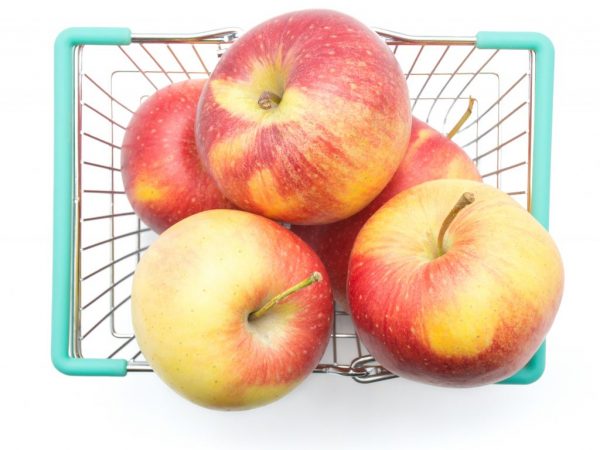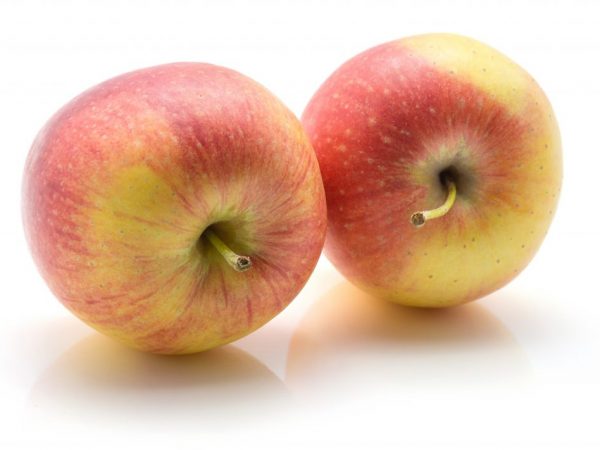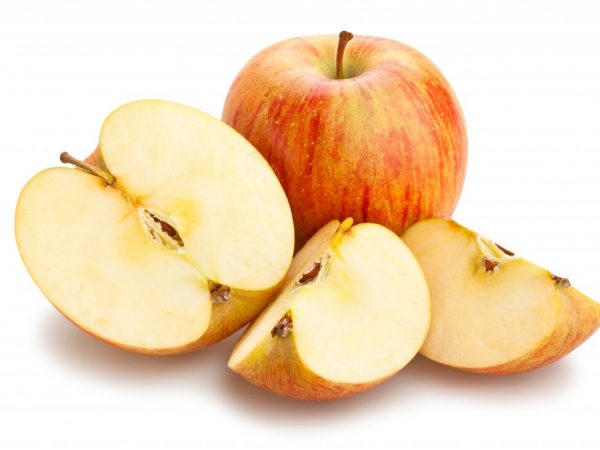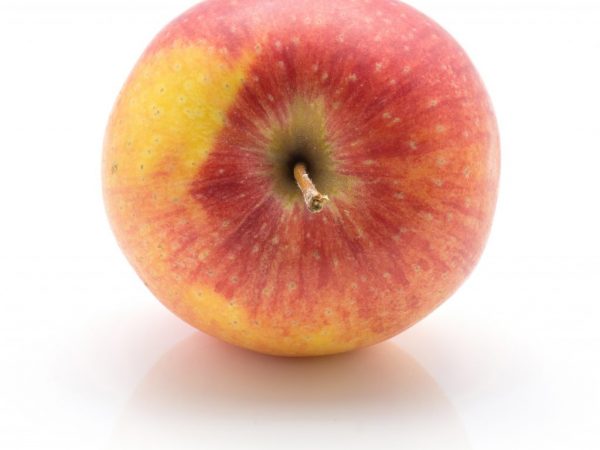Description of the apple-tree variety Orlovskoe Striped
The top ten elite varieties include the Orlovskoye Polosatoye apple tree. This early-growing hybrid has a pleasant taste, good disease resistance and consistently high yields. Thanks to these qualities, the tree has gained great popularity among many gardeners in our country.
- Varietal characteristics
- Wood
- Fruit
- Yield indicators
- Winter hardiness
- Disease resistance
- Pollinators
- Pros and cons of culture
- Landing rules
- Seat selection
- Preparation of planting material
- Harvesting a pit
- Timing
- Landing technique
- Agrotechnics
- Care features
- Top dressing
- Watering
- Loosening
- Preparation for wintering
- Pruning
- Flowering period
- Disease protection
- Pest control
- Ripening and fruiting
- Features of growing in the regions
- Gardeners reviews

Description of the apple-tree variety Orlovskoe Polosatoye
Varietal characteristics
This is one of the most popular varieties that is grown in the Volga-Vyatka, Northern, Middle, Central, Middle Volga, Chernozem and Northwestern regions.
Wood
The plant does not differ in intensive growth, in mature age the crown of a spherical shape reaches 4-5 m in height. Leafiness and thickening are average.
With age, the diameter can vary from 3.5 to 4.5 m. The root system is well branched, reaching 2.5 m in length.
Branches are smooth, brown in color, erect. The leaves are large, dark green, lanceolate with a pointed tip.
The flowers are pale pink, large, and are formed on fruit twigs.
Fruit
The apples of the Orlovskoe Striped variety are round-conical in shape, large - weighing from 120 to 150 g. The skin is golden, oily, smooth, contains numerous blotches of purple and pinkish blush. The pulp is juicy, firm, creamy.
The fruits are rich in vitamins, minerals, and contain a large amount of sugars and ascorbic acid.
They taste sweet with a slight sourness, have a pronounced apple aroma.
Yield indicators
This variety is one of the most productive - up to 200 kg of Orlov apples are harvested from 1 hectare.
From a tree 6-8 years old, 40-50 kg of fruits can be removed, from older trees (10-15 years old) about 80 kg of fruits are removed.
Winter hardiness
According to the description, the apple tree has poor frost resistance, but it is excellent for cultivation in the Oryol region.
Many gardeners successfully grow it in the Northern Zone. For successful growth and fruiting, they give a stale crown shape - they cut out the apical shoots and leave the lower skeletal branches, which in winter can be covered and sprinkled with a snowdrift, protecting it from severe frosts.
Disease resistance
The plant is highly scab resistant. To prevent infection with other infections, it needs preventive treatment with chemicals.
With good care and maintenance, an apple tree can live up to 40 years.
Pollinators
According to the description, the Orlov striped apple tree is partially self-fertile, therefore, pollinator varieties are additionally planted on the site:
- Slav;
- Titovka;
- Folding;
- Anise striped;
- Scarlet anise;
- Welsey;
- Orlik;
- Memory of a warrior;
- Autumn striped.
Pros and cons of culture

This variety is high-yielding
Benefits:
- early maturity - the first fruit ovaries are formed already in the fourth year after planting;
- the crop has an excellent presentation and excellent taste;
- high resistance to the most common disease - scab;
- high yield indicators - from 60 to 80 kg of juicy and tasty fruits can be removed from one adult tree;
- in comparison with other varieties, the fruits of this tree have good keeping quality and can be stored until January at a temperature of 1-2 ° in a refrigerator, cellar or basement.
This fruit crop has several disadvantages:
- the fruits have a very delicate and thin skin, so the harvest should be done carefully so as not to damage their integrity;
- poor tolerance to dry climatic conditions;
- high risk of kidney freezing during late autumn frosts.
Landing rules
Successful cultivation depends on some important points - the place and time of planting, the quality of the planting material and the further care of young trees.
Seat selection
The place in the garden should be well-lit, since in a shaded place the yield indicators are significantly reduced and the fruits ripen not so tasty and juicy.
In an area with a surface passage of groundwater, good drainage must be done, which will prevent waterlogging of the roots and their further decay. Sand, crushed stone or broken bricks are used as a drainage layer.
The tree grows well and bears fruit on loamy or sandy loam soil with a neutral acidity level.
To increase immunity and productivity, mineral and organic fertilizers are introduced into the soil.
Preparation of planting material
Depending on the state of the plant, different preparation of the planting material is used:
- Seedlings with a closed root system are deepened into the ground without any preparation.
- Plants with an open root system are examined for the presence of diseases, pests, all damaged parts are removed, and the roots are dipped in a clay mash for a couple of hours. A third of the leaves on the plant are removed.
- The root system of the plant should not be touched - the more roots, the better and faster the seedling takes root in a new place.
Harvesting a pit
Soil preparation is carried out in the fall - fertilizers are applied to the site (1 bucket of compost, 1 kg of wood ash, 1 kg of peat, 80 g of superphosphate and 50 g of potassium salt). After that, a deep digging of the site is carried out.
Before planting, the soil is loosened, leveled and dug holes with a depth of about 1 m and a diameter of about 80 cm.The optimal distance between seedlings is 4-4.5 m.
Timing

Beautiful and ripe apples
You can plant a tree in spring (mid or late April) and autumn (late September).
Autumn planting is preferable, since the plants take root better and faster after planting.
Landing technique
The roots of the seedlings are lowered into the ground, leveled and sprinkled with garden soil.
When planting, it is important to observe the depth level - the root collar should remain 5-6 cm above the soil surface. This will prevent the risk of its rotting in the future and the death of a young tree.
Agrotechnics
The plant nutrition area will depend on the rootstock:
- vigorous - 20-25 m²;
- medium-sized - 12-15 m²;
- dwarf - about 10 m².
Care features
Top dressing
For an apple orchard grown on black soil, no fertilizing is needed. When planting on sandy loam or loamy soil, fertilizers are applied annually.
The first feeding is carried out in the second or third year after planting the trees - about 10 kg / m² of humus or compost is applied. They are fed several times a season, after which the soil is shed with water so that the roots of the plant can fully assimilate all the nutrient components.
At the stage of flower bud formation, a urea solution is introduced (300 g per bucket of water). You can replace this fertilizer with a manure solution (5 liters per bucket of water).
Two weeks later, after the apple trees have bloomed, the following composition is introduced: nitrophoska (150 g), sodium humate (5 g). The resulting mixture is dissolved in 30 L of water. With the onset of autumn, trees are fertilized with complex fertilizing without nitrogen content (superphosphate - 2 tbsp. L., Potassium - 1 tbsp. L. And calcium - 1 tbsp. L.).
Watering
During the whole season, young seedlings need to be watered at least 5 times. The watering procedure is carried out in the morning and evening hours, pouring 2 buckets per day under each instance.
This tree does not tolerate waterlogging of the soil, so the frequency of watering should be adjusted taking into account the weather conditions.
Plants experience the greatest need for moisture during the period of laying flower buds and pouring fruits - in mid or late August.
The last watering is carried out in late summer or early autumn, when the plant will drop foliage. This increases the resistance of the tree against freezing in winter.
Loosening
After watering, the soil is loosened to maintain its moisture and air permeability. It is also necessary to promptly remove weeds that thicken the garden and deplete the land.
Preparation for wintering
Before sheltering, tree trunks are processed: copper sulfate (280 g), casein glue (150 g), acrylic paint (200 g), hydrated lime (2, 3 kg) are mixed.
Before the beginning of the first autumn frosts, the trunk circle is mulched with rotted cow or horse manure. Additionally, the barrel is wrapped with any non-woven material.
A net is used to protect trees from rodents. She is wrapped around the near-barrel area over the covering material.
Pruning

Good harvest with proper apple tree care
Usually, a sparse-tiered crown formation is used for an apple tree. Each row consists of 3-5 skeletal branches. Depending on the age of the tree, a different pruning technique is used:
- Two-year-old seedlings with a closed root system are pruned for the first time immediately after planting - 1/3 of the central conductor is cut off in order to stimulate the establishment of skeletal branches. All subsequent pruning is carried out every spring - before the start of sap flow. Usually this manipulation is carried out in the beginning or mid-April.
- In annual plants with open roots, the root system and the aerial part are shortened. The trunk is cut at a height of 1 m. Sanitary haircuts are also carried out if necessary. All shoots formed below the first row of skeletal branches must also be cut into a ring. The optimum stem height is 50 cm.
Branches spoiled by frost, diseases and pests are cut into a ring. Places of cuts are treated with garden varnish to prevent further infection of the tree. Also, all shoots that grow inside the crown and descend to the bottom are subject to cutting. For the development of the crown, the thickest and strongest branches are left growing upward. When carrying out the pruning procedure, it is important not to overdo it - you can only remove 1/4 of the shoots of the total number of branches on the tree. If you cut more, the tree may die.
The rejuvenating procedure is carried out at 8-10 years of age. The entire five-year increment is shortened by a third of the length. Also, all old branches affected by diseases, frost and winds are cut into a ring.
Flowering period
To increase the immunity of trees and their survival rate, it is necessary to normalize flower inflorescences - in the first year, all inflorescences are cut off.
In subsequent years, 50% of the total number of flowers on the tree. This manipulation improves the quality of the crop and makes it possible to get large fruits.
Disease protection
Spraying the crown and soil around the trunk is carried out at the beginning of spring, even before the buds begin to bloom. For preventive purposes, the crown is treated in early spring and late autumn with copper-containing preparations - copper sulfate or Bordeaux mixture.
In the fight against powdery mildew, a solution of colloidal sulfur is used - 80 g of the substance will be dissolved in a bucket of water.
Processing is carried out 5 times: in early spring, after blooming flower buds, then 3 more times every 2 weeks.
Plants suffering from cytosporosis are treated with copper sulfate. After the tree has faded, Hom is used. And to increase resistance to disease, nitrogen-containing preparations are introduced into the soil - Nitroammofosk or Nitrofosk.
Pest control
To avoid the invasion of parasites, trees are irrigated with a urea solution for prevention. The trunk of the plant is smeared with slaked lime.
Fitoverm, Aktellik, Karbofos, a mixture of copper sulfate and lime are used to destroy aphids.
Several effective remedies will help to cope with the moth - Actellic, Lepidocid, Karbofos, Fitoverm and Entobacterin.
All chemical treatments of the tree during the period of budding and the formation of fruit ovaries are prohibited, since they can negatively affect the quality and taste of the fruit.
Ripening and fruiting
The Orlovsky Polosaty variety ripens in the first half of September, the fruiting of the apple tree is stable, annual, with good care, the yield is high.
The harvested fruits can be stored in any cool room with a humidity level of about 60% and a temperature of 1-2 °.
There are several options for storing apples:
- In wooden boxes. The fruits are laid in layers, shifting each layer with cardboard. With a small amount, each fruit can be individually wrapped in newspaper. In such conditions, apples can be stored until January.
- Bulk in wooden containers.
- In the refrigerator - in the section for storing fruits and vegetables.
- In apartment conditions, the crop is stored on a glazed balcony or loggia with the possibility of shelter in severe frosts.
Features of growing in the regions
Depending on the region, the rules for growing apple trees of the Striped Prlovskoe variety differ:
- In the Moscow region, the optimal time for planting a plant is the last decade of September.
- In the Urals, it is grown in stanza form to avoid freezing in winter.
- In the Leningrad Region, garden soils are very poor, therefore, before planting seedlings, the site should be thoroughly fertilized with organic matter and mineral components. For resistance from cold weather, they are planted in a place protected from the winds from the south or southwest side of the house.
Gardeners reviews
This culture is grown in many regions of our country, and almost all gardeners leave positive reviews.
The apple variety Orlovskoe Polosatoe has the most valuable qualities - stable yield, disease resistance, unpretentious care and excellent fruit taste.
Observing all the above described planting and care rules, you can successfully grow such a tree in your garden.

